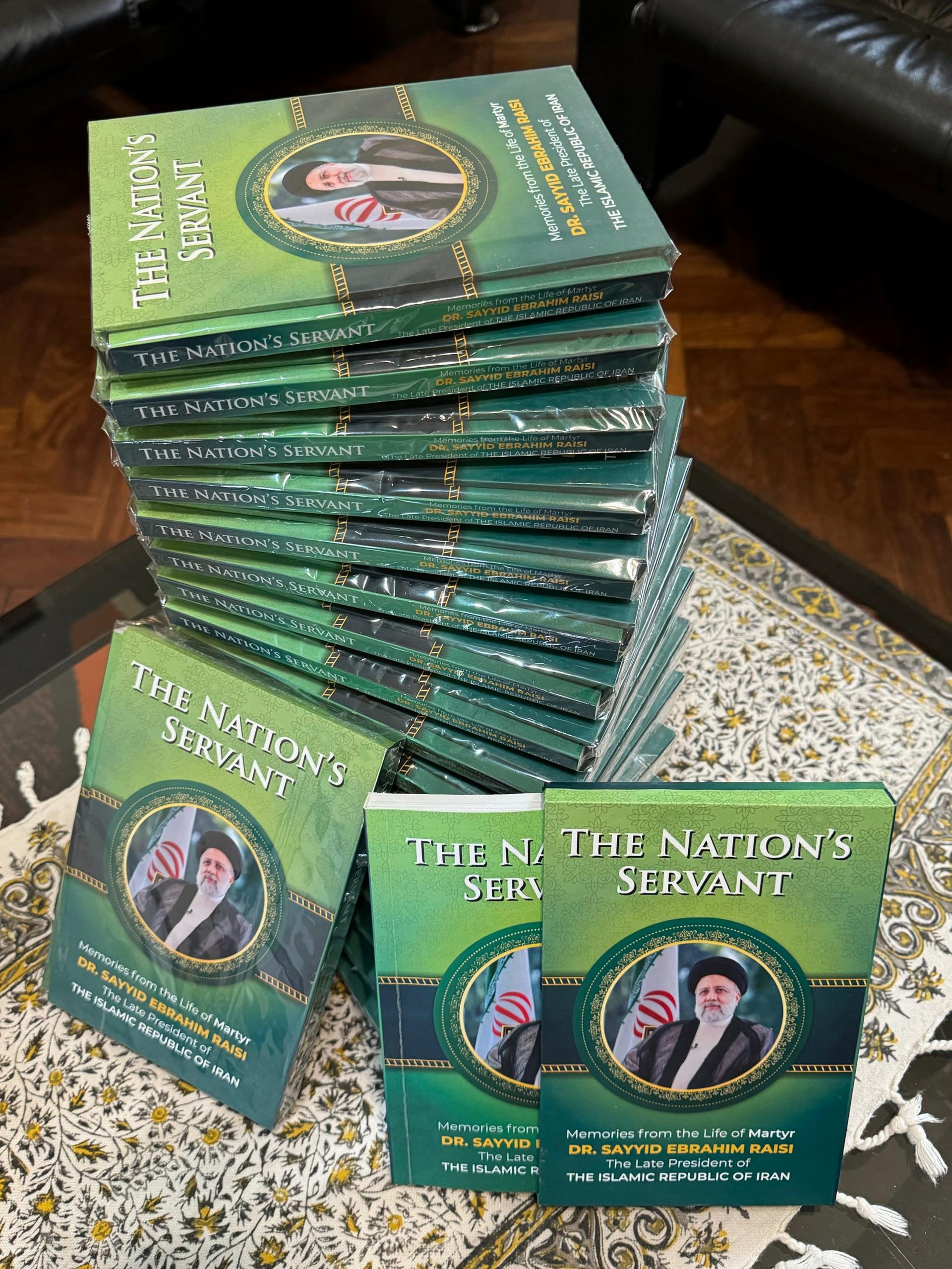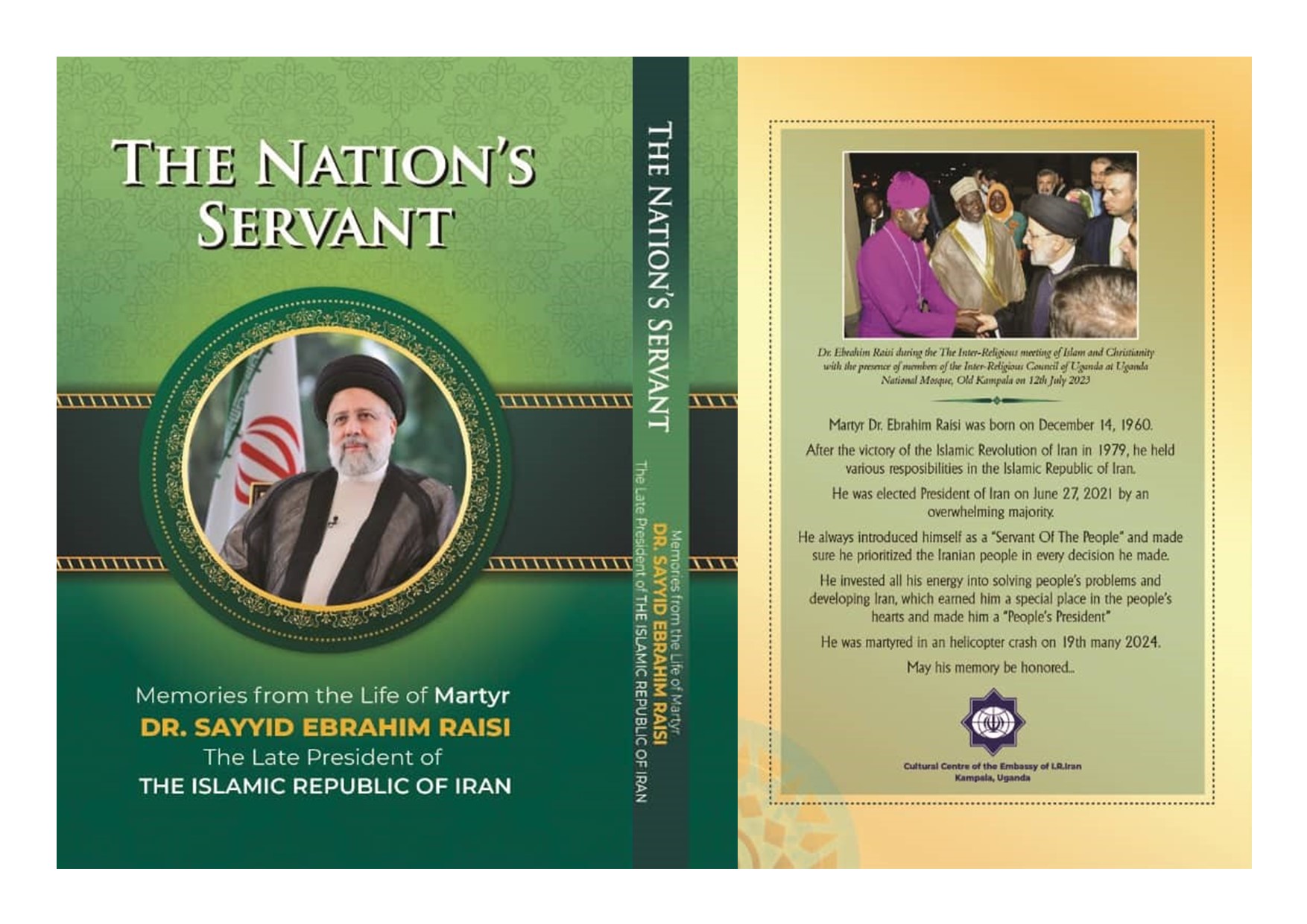The life of Nation′s Servant book published in Uganda
Dr. Sayyid Ebrahim Raisi was born on December 14, 1960, into a clerical family in the Noghan neighborhood of Mashhad. His father was Hujjat al-Islam Sayyid Haji Rais al-Sadati, and his mother was Sayyidah Esmat Khodadad Husayni, a descendant of the Husayni sayyids. His lineage on both sides traces back to Imam Sajjad (a). Sayyid Ebrahim lost his father when he was five years old. He completed his primary formal education and preliminary seminary courses in Mashhad. Then, in 1975, at the age of fifteen, he went to the Islamic Seminary of Qom, specifically the Ayatollah Boroujerdi School, to continue his studies.

The Nation′s Servant
Sayyid Ebrahim Raisi was born on December 14, 1960, into a clerical family in the Noghan neighborhood of Mashhad. His father was Hujjat al-Islam Sayyid Haji Rais al-Sadat, and his mother was Sayyidah Esmat Khodadad Husayni, a descendant of the Husayni sayyids. His lineage on both sides traces back to Imam Sajjad (a). Sayyid Ebrahim lost his father when he was five years old. He completed his primary formal education and preliminary seminary courses in Mashhad. Then, in 1975, at the age of fifteen, he went to the Islamic Seminary of Qom, specifically the Ayatollah Boroujerdi School, to contine his studies.
Following the triumph of the Islamic Revolution, Sayyid Ebrahim, who had completed advanced seminary studies in Qom, began his first judicial role, relying on his scholarly and jurisprudential background. In 1980, at the age of 20, he became the assistant prosecutor of Karaj; shortly thereafter, he was appointed by Shaheed Ayatollah Qoddusi to the position of prosecutor. In 1982,
just two years into his successful tenure in Karaj, he simultaneously took on the position of prosecutor of Hamadan.
Sayyid Ebrahim Raisi married Jamileh-Sadat Alamolhoda, the daughter of Ayatollah Sayyid Ahmad Alamolhoda, at the age of 23. The fruit of this marriage are their two daughters.
In 1985, Raisi moved to Tehran as the deputy prosecutor. From 1989 to 1994, he served as the prosecutor of Tehran, and then for ten years, he was the chairman of the General Inspection Office of Iran. Ayatollah Raisi was appointed as the first deputy of the Judiciary, a position he held for ten years. Following this, he served as the country’s prosecutor-general for sixteen months.
Following the passing of Ayatollah Vaez-Tabasi in March 2016, Ayatollah Raisi moved to Mashhad and served as the custodian of the Holy Shrine of Imam Reza (a) for three years; he was appointed by the decree of Ayatollah Khamenei. During this period, he implemented extensive changes in the administrative structure of the holy shrine, aimed at providing greater service to the disadvantaged, as well as to the pilgrims and neighbors of Imam Reza (a). In March 2019, Sayyid Ebrahim Raisi returned to the judiciary and assumed the role of chief justice. With his exceptional management skills, he elevated the stature of the institution. Some of Ayatollah Raisi’s most notable actions in this position included promptly addressing people's cases and judicial issues, decisively investigating corruption cases, digitizing the Judiciary, and finally, drafting and finalizing the document on judicial transformation.
Sayyid Ebrahim Raisi, who had run for the presidency in 2017 but failed to secure a majority of votes, became a candidate once again in the 2021 presidential election following requests from a large segment of the population. Garnering 62 percent of the votes, he earned the opportunity to assume the presidency and establish a successful track record in this arena as well.
During his three years as president, Ayatollah Raisi made tireless and wise efforts to improve economic and livelihood issues, reform administrative processes, actively engage in foreign policy, and hold numerous public meetings. He also traveled to all provinces of the country, completing nearly two rounds (forty-seven trips) to visit and follow up on the progress and development of government approvals in the provinces. On his last trip, on the evening of Sunday, May 19, while returning from the inauguration ceremony of the Qiz Qalasi Dam in the north of East Azerbaijan towards Tabriz, his helicopter crashed. Along with all the passengers of the helicopter, he attained the lofty status of martyrdom.
Alongside his executive and judicial work, Sayyid Ebrahim Raisi was known as a cultural and scholarly figure. During his studies at the Islamic Seminary of Qom, he learned from esteemed scholars such as Shaheed Ayatollah Motahhari, Shaheed Ayatollah Beheshti, the late Ayatollah Hashemi Shahroudi, and Ayatollah Sayyid Ali Khamenei. In addition to achieving the highest seminary degree (the fourth level of seminary studies), he earned his doctorate in jurisprudence and private law in 2013.
Throughout his many years as a seminary student, alongside his judicial, executive, propagation, and preaching activities, Raisi also engaged in teaching advanced seminary courses. From 2016 onwards, he began teaching advanced jurisprudence (kharej-e fiqh) and Quranic exegesis in Mashhad. Raisi has also authored several books on law and jurisprudence.
Following his martyrdom, in addition to five days of national mourning in Iran, public mourning was declared in Lebanon, Syria,Tajikistan, India, Pakistan, Turkey, Iraq, and Cuba. The flag of the United Nations and all member countries in Vienna was flown at halfmast as a sign of respect. Members of the United Nations Security Council and the International Conference on Nuclear Security in Vienna also observed a minute of silence in his honor at the beginning of their sessions.
Funeral ceremonies were held for him in the cities of Tabriz, Qom, Tehran, Birjand, and Mashhad. The total number of mourners in these cities has been estimated at more than twelve million people. Hundreds of thousands of people around the world in countries such as Iraq, Lebanon, India,Pakistan,Syria,Kashmir, and other parts of the world held memorial ceremonies in his honor. After his martyrdom, Iranians bestowed upon him the title of Martyr of Service and Servant of the Nation in recognition of his countless services durig his fortyfour years of activity. He is now recognized in Iran and many countries as a symbol of a popular and active president.


